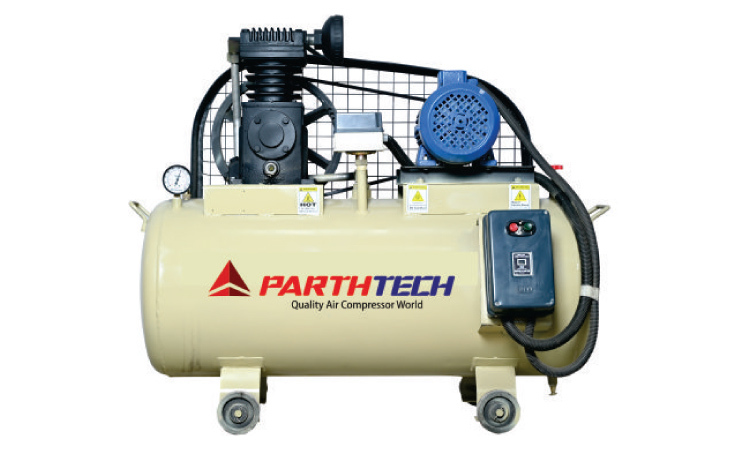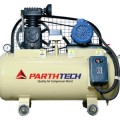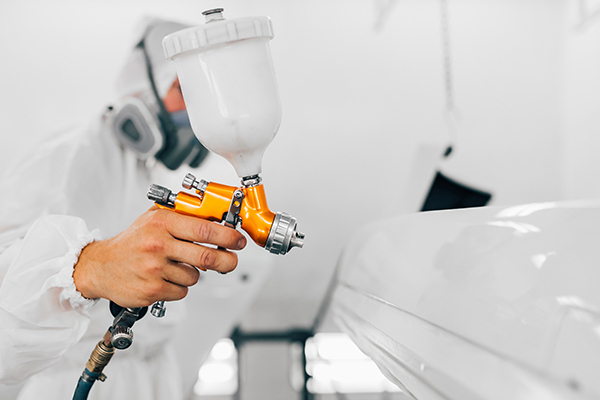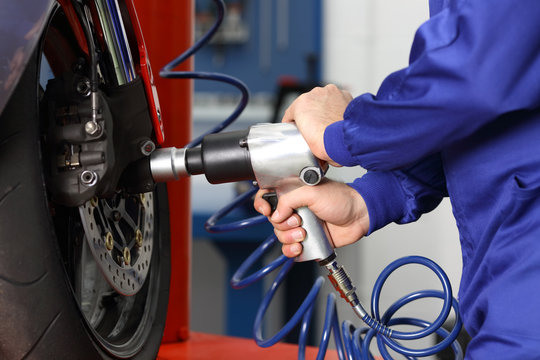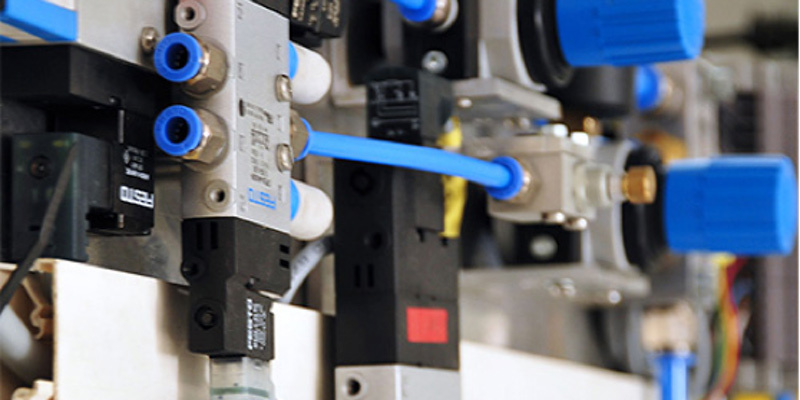-
Call
-
Whatsapp
9825014048
-
Location


Single Stage Air Compressor
Single Stage Air Compressor
Application: Chemical Industries, Power Coating Industries, Spray painting.
A single-stage air compressor is a type of air compressor that compresses air to a specific pressure level in a single stage or compression cycle.
These compressors are commonly used in various industries and applications where moderate to high-pressure air is required.
Single Stage Air Compressor
Single compressors compress air to increase pressure for industrial, commercial and personal applications. Unlike a dual-stage compressor with two cylinders, a single-stage compressor has a single cylinder, making it more straightforward in design and more suitable for specific applications
Here is a brief introduction to one-dimensional air compression.
- Principle of operation: One-stage air compressors operate in a straight line. The ambient air is sucked in, and the air is compressed by a piston in the cylinder to a higher pressure.
- Applications: These are generally used for applications requiring high-pressure air, such as powering pneumatic tools, inflating tyres, spray ammunition operations, deep industrial applications, lightweight to lightweight and versatile machines in offices, construction sites, auto repair shops, and so on.
- Efficiency: A single-stage compressor provides a continuous source of compressed air. It is designed for intermittent use and can constantly flow compressed air at a specified pressure.
- Compact configuration: These compressors are generally compact and portable, making them suitable for mobile applications.They are offered in various sizes and configurations to meet various needs.
- Maintenance: These air filters are generally easy to maintain, so regular checks on oil levels (in oiled form), air filters, and safety features are essential
- Cost Effectiveness: Generally less expensive than two-stage compressors, making them appealing to those with specific budget constraints or needs
- Limitations: Single stage compressors work well for many applications but may not be suitable for heavy or continuous industrial applications.Two-stage compressors providing high pressure are well suited for such purposes.
What Is a Single-Phase Compressor?
A single-stage compressor is an air compressor that operates in one pressure cycle to increase air pressure. This relatively simple and standard compressor is used in a variety of applications.
Business Principle:
- Air is drawn through the intake valve into the cylinder during the draw or intake stroke in a one-piece compressor.
- A piston driven by an electric motor or engine compresses the air produced during compression.
- The compressed air is transported from the exhaust to the storage or processing unit.
Key Characteristics:
- Single Compression Stage: As the name suggests, single-stage compressors have only one compression stage, which means that air is forced once per cylinder
- Medium Pressure: Single-stage compressors suit applications requiring medium to slightly higher air pressure. However, it is generally not used in high-pressure applications.
- Compact and Portable: These compressors are typically compact and portable, making them suitable for mobile site use.
- Efficiency: They provide a continuous source of compressed air flowing constantly at a specific pressure.
- Versatile: Single-stage compressor is used in various applications, including factories, construction sites, auto repair shops, tyre filling stations, air-powered compressors, and more.
- Maintenance: Maintenance is generally easy, so it is important to check oil levels (for oil-lubricated machinery), air filters and safety features
Limitations
Single-stage compressors may not be suitable for heavy or continuous industrial applications requiring very high air pressures. Two-stage compressors have an additional compression stage and are commonly used for such applications.
How Does a One-Sided Air Compressor Work?
- Ventilation: The process begins with ventilation.Atmospheric air is drawn into the compressor through an air filter. Air filters remove dust, debris, and other contaminants from the incoming air, improving the compressed air quality.
- Compression cylinder: After extracting the gas, it enters the compression cylinder. In a single-stage compressor, compression is generated in a single cylinder.
- Compression stroke: A piston connected to the crankshaft inside the cylinder moves downward during a compression stroke, reducing the volume in the cylinder. Air becomes compressed and more pressured as its volume decreases.
- Valves for intake and discharge: There are valves for intake and discharge on the cylinder. During the intake stroke (when the piston rises), the intake valve opens, allowing atmospheric air into the cylinder. During the compression stroke (when the piston moves down), the intake valve closes, and the discharge valve opens. This prevents the compressed air from flowing back into the cylinder, leading to the storage area or control.
- Compressed air delivery: Compressed air is delivered through an open discharge valve and stored in a pressure tank (if the compressor has a tank) or delivered directly to the application through air pipes and hoses.
- Pressure system: These compressors usually have pressure switches controlling the tank's air pressure. When the pressure reaches a predetermined level, the compressor motor shuts down. As the pressure decreases due to use, the motor turns again to maintain the desired pressure.
- Release of Excess Heat: Heat is generated during the compression process. Some single-stage compressors have cooling fins or other devices to dissipate this heat and prevent overheating.
- Repeat Cycle: The compressor continuously cycles on and off as necessary to maintain the desired air pressure in the tank or to meet the air demand of associated equipment or equipment.
Single-Stage Air Compressor: Capabilities and Weaknesses
The one-dimensional wind is a marvel of mechanical valuable simplicity in various applications, from powering wind tools to acting as a reliable workhorse in industrial situations. Let us examine its essence and analyze its importance.
- Air intake and filtration: The air intake system is centrally located in a single-stage air compressor. This begins the intake process, where atmospheric air is drawn in. The intake filter ensures that the air is clean and protects the internal workings of the compressor. This feature checks for dust, dirt and contaminants to provide good air quality.
- Compression cylinder and piston: The compression cylinder is the star of the show and the only one in a one-stage compressor. In this cylinder, a piston moves equally up and down. This reverse motion is driven by a coupling crankshaft, which generates the mechanical power necessary for compression.
- Valves: Intake and discharge valves play an essential role in operation. During the intake stroke, the intake valve opens, allowing fresh air to rush into the cylinder as the piston rises. In contrast, the intake valve closes, and the discharge valve opens during the compression stroke. This clever valve connection ensures that the compressed air flows in the correct direction to the intended destination.
- Compression Stroke: As the piston descends into the cylinder, the air trapped in it decreases. This decrease in volume forces the air particles closer together, increasing their pressure. This is the basic pressing process.
- Discharge: Compressed air at high pressure leaves the pressure cylinder through an open inlet. Depending on the configuration, it can be transferred to a container for later use or delivered directly to the application as a wind turbine or an industrial process.
- Pressure control: Many single-stage compressors have switches to maintain desired air pressure levels. A switch in the storage tank monitors the pressure there. When the pressure reaches a predetermined level, the compressor motor shuts off automatically. As the air runs out and the pressure drops, the machine restarts to maintain the desired pressure.
- Cooling systems and protective devices: Pressure generates heat, controlled by cooling systems such as fans and other cooling devices. This prevents overheating and improves compressor efficiency. Safety features have also been added to protect you from excessive pressure or overheating.
Single-stage compressors come in different sizes and configurations for portability and versatility. Some are small and portable, ideal for on-the-go accessories, while others are larger and meet technical needs.
Advantages of Single-stage Air Compressor
- Simplicity and Reliability: A single-stage air compressor is known for its straightforward construction. Fewer hardware and moving parts make it easier to operate and maintain. This simplicity often translates into more reliability.
- Cost: These compressors are generally more budget friendly than their dual-purpose counterparts. This makes it attractive for those with a cost or specific application that doesn't require much pressure.
- Efficiency for medium pressures: Medium to very high air pressures are good. Single-stage compressors offer an energy-efficient solution for operations within this range.
- Versatility: Single-stage compressors are versatile and find applications in different configurations. From home offices to construction and industrial sites, they can power pneumatic tools, inflate tyres, and more.
- Compact and portable options: Many single-piece compressors are designed to be compact and portable. This navigation is helpful for on-site mobile applications.
- Ease of maintenance: These compressors are generally easier to maintain than complex systems. Routine checks of oil levels (for oil-lubricated machines) and air filters are generally straightforward.
Features of Single Stage Air Compressor
- Simplicity: Single-stage compressors are known for their simple, easy-to-understand design, which makes them accessible even to those with limited technical skills.
- Cost-effective: These compressors are generally more affordable than their two-stage counterparts, making them available to a broader range of users, including homeowners and small businesses.
- Efficiency: Single-stage compressors work well for applications requiring moderate to high air pressure. They excel in areas such as air-powered equipment and inflated tyres.
- Versatility: They find value in various environments, from home garages and offices to construction and industrial sites. This versatility makes them a practical choice for a wide range of projects.
- Portability: Single-stage compressors tend to be compact and portable, making them easy to transport between jobsites.
- Controlled Pressure: These compressors generally have a pressure control that turns the motor on and off automatically to maintain the desired air pressure in the storage tank.
- Easy maintenance: Routine maintenance tasks, such as checking the oil level (for oil-fired appliances) and cleaning or replacing air filters, are generally easy and user-friendly has been done.
- Cooling System: Some models have cooling fins or other systems to dissipate the heat generated during compression to help prevent overheating.
- Noise Level Options: Depending on the design and size, single-stage compressors can be relatively quiet, which is essential for noisy environments.
- Duty cycle: Manufacturers specify the duty cycle, which determines how long the compressor can operate without overheating. This information helps users understand the compressor’s capabilities for continued use.
- Pressure Gauges and Regulators: Many devices come equipped with pressure gauges and regulators, allowing users to monitor and adjust air pressure as needed for specific applications
- Safety Features: There are safety features on some single-stage compressors, including thermal overload protection to prevent motor overheating.
- Oil-lubricated or oil-free option: Users can choose between oil-lubricated and oil-free options based on their preference and application.
- Pressure Rating: Single-stage compressors have different pressure ratings to accommodate various applications and projects.
Single Stage Air Compressor Specifications
| Model | Pistn Displacement | Max. Pressure | Motor H.P. | No, of Cyl. | Air Receiver (Ltr) | ||
| CFM | M 3 /H | Kg/CM 2 G | PSIG | ||||
| PT5 | 2.98 | 5.05 | 7.00 | 100 | 0.5 | 1 | 45 |
| PT10/1 | 3.73 | 6.32 | 7.00 | 100 | 1.0 | 1 | 70 |
| PT15/1 | 6.78 | 11.49 | 8.79 | 125 | 2.0 | 1 | 92 |
| PT15/2 | 8.25 | 13.98 | 8.79 | 125 | 2.0 | 2 | 92 |
| PT30S | 14.85 | 25.16 | 5.62 | 80 | 3.0 | 2 | 150 |
| PT75S | 23.90 | 40.50 | 5.62 | 80 | 5.0 | 2 | 225 |
| PT75S | 34.60 | 58.60 | 5.62 | 80 | 7.5 | 2 | 225 |
| PT100S | 52.80 | 89.50 | 5.62 | 80 | 10.0 | 2 | 225 |
| PT125S | 88.00 | 149.10 | 2.81 | 100 | 40 | 12.5 | 300 |
| PT200S | 148.50 | 251.70 | 2.81 | 40 | 20.0 | 3 | 500 |
Spray Painting
Single-stage air compressors are essential tools in the field of spray painting, where precision, consistency, and quality are paramount. These compressors provide a continuous source of compressed air, which is indispensable for the operation of paint spray guns and other painting equipment.
Powder Coating Industries
Single-stage air compressors are indispensable tools in powder coating industries, where the precise and consistent application of powdered coatings onto various surfaces is critical. These compressors provide a reliable source of compressed air, which is an essential component of the powder coating process.
Chemical Industries
Single-stage air compressors play a vital role in the chemical industry, where the reliable supply of compressed air is essential for various processes. These compressors are known for their simplicity and cost-effectiveness, making them well-suited for specific applications within chemical plants and facilities.


FAQs

Frequently Ask Questions
Single stage air compressor is a form of compressor that attracts air in a single degree or cycle. It works by way of drawing in air and then compressing it with pistons or a rotating impeller. The compressed air is then stored in tanks for numerous functions.
Single stage air compressors have many advantages, including: simple design and operation. Lower initial cost compared to multistage compressor. Suitable for applications requiring moderate to high air pressure.
Single-stage compressors have some limitations, such as: limited maximum compression capacity compared to two-stage compressors. Low energy efficiency for high-pressure jobs. Critical temperature increases during compression.
Single-piece air compressors are commonly used for applications such as: pneumatic tools and pneumatic tools, inflated tires and sports equipment, spray painting, small industrial applications
One-stage air filter maintenance includes regular oil level checks (if applicable), cleaning or replacing filters, inspecting belts and hoses, and draining tanks of the It is important to follow the manufacturer's maintenance instructions.

